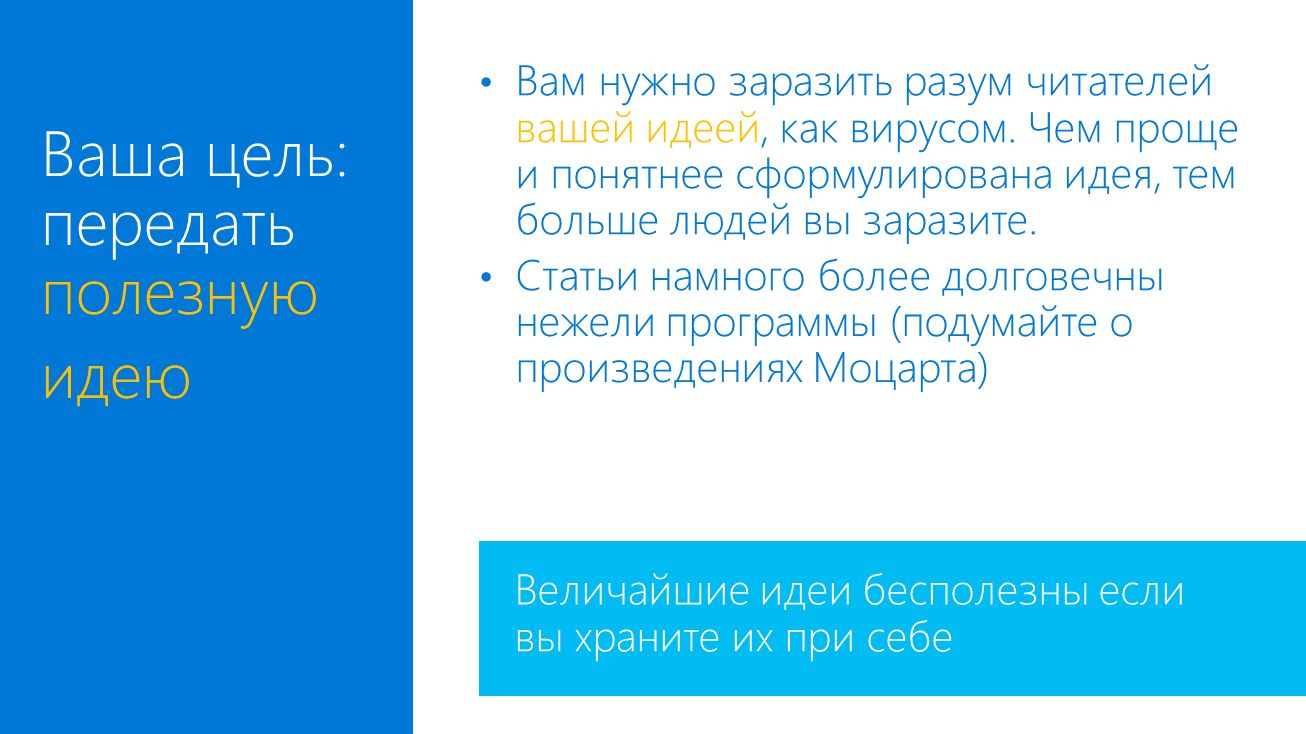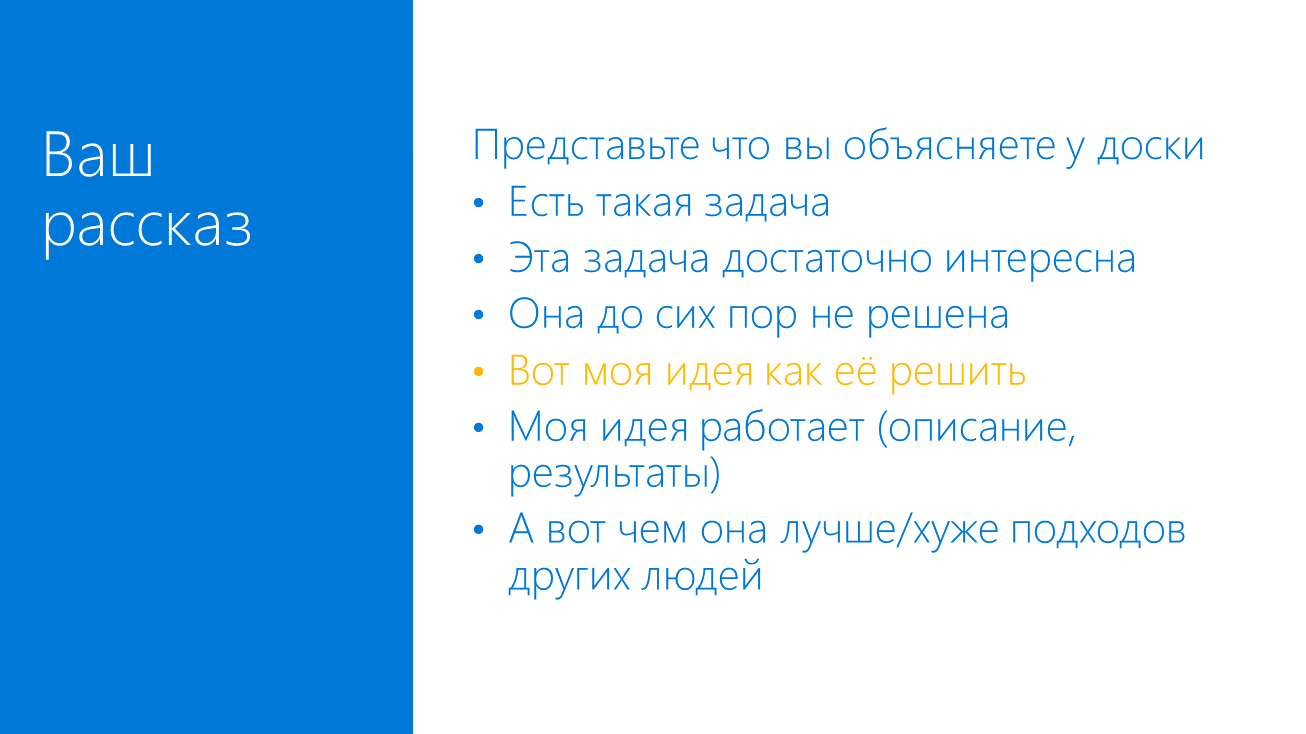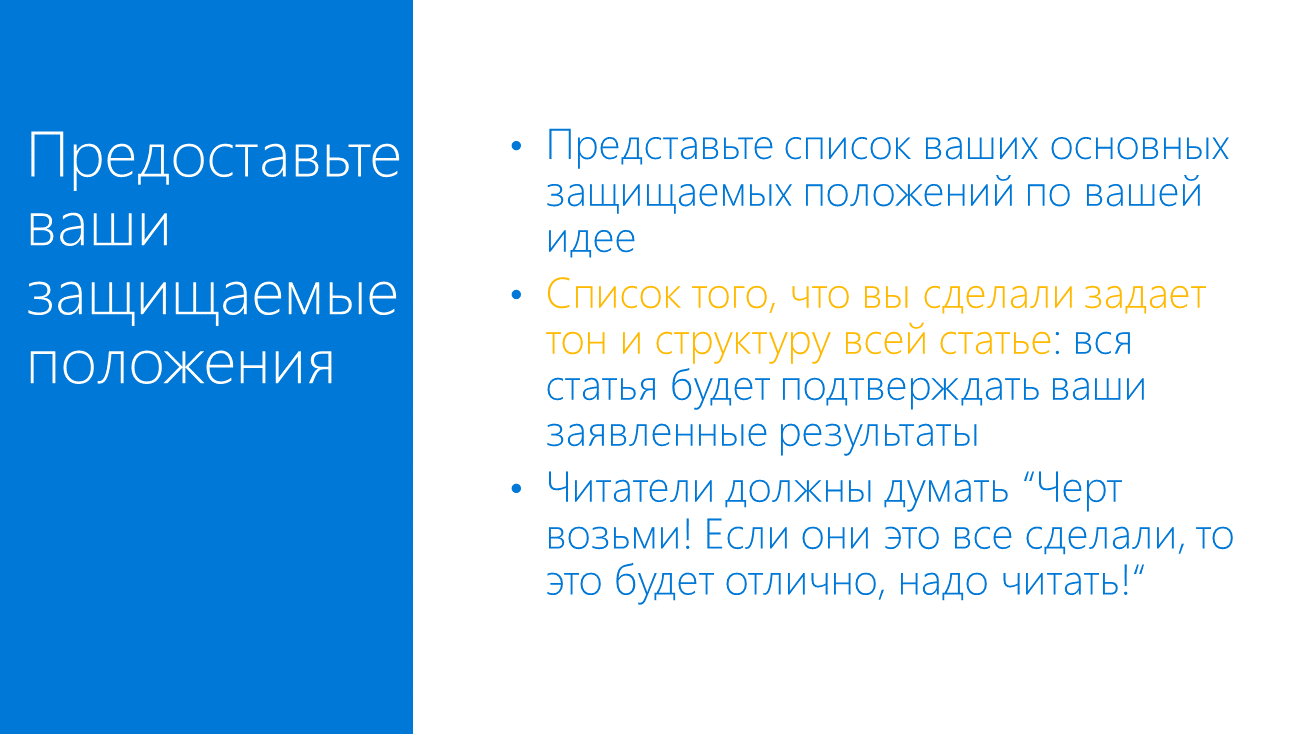How to write an excellent scientific article on CS
Hello!
I recently stumbled upon a recording of a very interesting talk by Simon Peyton-Jones (a leading Haskell language developer) at Microsoft Research Cambridge. In it, he tells students how to conduct research and write articles on Computer Science. His thoughts seemed to me very interesting, and applicable not only for the CS field.

')
Researchers, graduate students, students, and in general, people who write articles in scientific journals or who will soon have to ask for a cat where you can find my Russian adaptation of his presentation.
The main ideas are formed in seven tips, thanks to which your research and articles can become better:
In each piece of advice, I added one of the slides from the Simon Peyton-Jones presentation, it might be worthwhile to additionally flip through it. Though I tried to convey in the text the thoughts of the scientist in full, but the presentation style is good because it is a squeeze of the main ideas and is perfect for perceiving the essence of his advice.
The big problem is the article is the final stage of your research. Sounds logical, doesn't it? But this approach is wrong. A much better approach is to write your idea right after its occurrence. This will allow you to present it as clearly as possible in a formal language. And at this stage it may already be the case that you did not fully form your idea, or, it was initially wrong. Thus, this method allows you to form and polish your idea long before the study, or it can save many months or years that you could spend on an unsuccessful thought.
Express your ideas in the language of mathematics, function charts, pseudocode, or in any other formal way. Discuss this with colleagues in smoking rooms, at internal seminars or conferences. This approach allows you to start a discussion of your idea and your research with other people at an early stage, because unlike your thoughts, all your colleagues can understand the formal language. But first of all, it is necessary that you can structure your own thoughts and start a dialogue with yourself.
Article preparation is the primary method of conducting research, and not the way to publish it.

An article is not just the result of your work on a topic published in a journal or at a conference. This is a way to tell others about your idea, about your way of solving a problem. The idea ... it is like a virus, and the easier and clearer you can formulate it, the more people it will infect and the further it spreads. It is extremely important to formulate and convey your idea to the reader, because even the greatest ideas are useless as long as you keep them with you.
Your ideas will live much longer than your research or programs you write. The works of Mozart are so catchy that many musicians at all times come back to them and perform in philharmonic societies with them or their interpretations. We still listen to the works of Mozart in philharmonic societies, because they were recorded in a language that every musician understands. Perhaps in a hundred years nobody will start your program, and the idea embodied in it and presented in the article will live for a long time.
Sometimes it seems to you that your idea is not worthy of publication, that there is no point in wasting time on it, and other scientists have done everything for you for a long time and better. This is a mistake haunting many scientists. Unwittingly comparing ourselves with outstanding researchers in our field, we sometimes belittle the results of our work. Give yourself a chance - tell us about your idea. Let the scientific community decide for itself how good or bad your article is, because without trying to publish it, you don’t leave it any chance at all.
Do not wait for great ideas - just tell the world about your ideas. And it may turn out that one of them will be great.

Regardless of what you write, whether it is an article in a prestigious magazine or in your blog, notes for streaming lectures or seminars, it makes sense to follow a certain sequence in your presentation. Imagine that you are standing at the blackboard and you want to talk about your idea. And the task is, using only the materials at hand, to try to bring it to your listeners. You will start with what the actual problem is. Then move on to why it is important to you or other people. Then tell about your idea of its solution, going to the details: theorems, proofs, experimental results, etc. Then you need to explain why your idea is better than others. Or maybe something worse?
The structure of a scientific article in a journal or a conference looks the same way:
The brackets indicate how many people will read certain parts of your article. ( Note: these are not experimental results, but simply Peyton-Jones's assumptions ). The audience plummets after your introduction and it is crucial to bring out the key points: your idea and the positions you put on defense.
By the way of narration, a scientific article is not much different from an article in your blog or story. Try to write so that the reader would be fascinated by your narration.

The introduction is the locomotive of your article and, if you want to keep the reader, every word written in the introduction is valuable. This part can not be scattered. The only thing that should be in it is the definition of the problem you are solving and its importance, as well as the main provisions of the article put forward for protection. Everything. This should be placed on the first, front, page of your article.
Often, an admitted error in the presentation of a problem lies in its too large generality and, as follows from this, the obviousness:
But isn't it clear that there are and will be mistakes in the programs? This urgency of the problem is obvious. Instead, write what specific problem led you to work on the article, even if it is just a slight reflection of the great Problem in which you act:
And instead of yawning and flipping through your article, the reader will think about whether it didn’t meet him at work or maybe he would think how he himself would solve this particular problem. Here at this moment you hooked him.
Do not produce excessive complexity in the article. Describe exactly the problem that will be solved.
Further, the text should provide the main provisions of the article, which you will further protect. It is better to do this in the form of a selected list. Each of your provisions should be accompanied by a link to a specific section of the article in which you will defend your position. Every position you defend must be falsified. By submitting the introduction in this form, you will greatly facilitate the work of the reviewer and add harmony to your story. For example:
Imagine that the introduction of your article is a prototype, and its body is a realizable functional. Make it so that your article compiles.

It would seem a good approach to tell different approaches to solving your problem that have already been implemented and published before you before describing your idea. This is a good academic approach - before you do something you first learn what has been done before you. No one wants to rediscover the bicycle again, does it?
The point is that such an approach is good for research, but terrible for preparing an article. The main objective of the article is to transfer your idea to other researchers, and the description of existing approaches serves as a wall between the reader and your idea. The more different approaches you describe, the more difficult it will be for the reader to get to your particular point.
Two main reasons why you should not write a literary review before your approach:
Placing a literature review after your method is counterintuitive and contrary to the academic approach, but this has its meaning, and this contributes to the achievement of the main task - to convey your idea to the reader.

Before that, we considered the introduction of the article. Now we will touch directly on the main body - the presentation of your idea, methodology and technical details. And the most important thing that I would like to say first of all - do not repeat in the article your way of solving the problem. An article is not a retelling of your research; it is a way to convey your idea to the reader. Your path can be thorny and winding, it can be sprinkled with your blood and suffering, you could look for a solution for several years by trying completely different techniques. The reader does not need to know all this, try to find the shortest way to present your main idea to the reader. The exception is the moment when the reader might think - “Why is this path not chosen, does it seem obvious and simpler?”. You may know that this obvious and simple path leads to a dead end. In this case, this should be indicated in the article.
During the presentation of your method, a good approach will go from the particular to the general: you can start with a specific example that will show how your method works. This is important for the intuitive perception of your approach. After that, the reader, having an intuitive understanding, will be able to understand your further generalization. And even if the reader misses your generalization, he will have an intuitive understanding of your idea and how it works in practice, and perhaps it will be useful to him in the future.
Make sure that the reader intuitively understands your basic idea.

As has been repeated in many other tips - listen to your reviewers. This is one of the advantages of early text preparation. You can give it to your colleagues, friends and acquaintances in advance. Maybe your sports team friends have a bad understanding of Computer Science, but they understand the condition in the first couple of sections, and they can tell you that somewhere they are lost or confused. Correct this place.
Remember that you have only one chance for a first impression! If one colleague read your article and found errors, try to show the corrected version to another. The closer a colleague is to your area of expertise, the deeper he will be able to penetrate your article.
Understand exactly what you want to get from the review of your article. Your friends and colleagues will be glad to point out grammatical and stylistic mistakes to you, but they will try to keep silent about the moments when they are confused or did not understand something. They will blame themselves, but these are not their mistakes, but yours. Make sure they understand your thoughts correctly and are not confused anywhere in the text, be sure to ask them about it.
You can get a review from a professional in your area before the official review through the editors of the journal. Just send him a draft of the article with a request to clarify whether you are using his method correctly, which he published in his article to which you refer. Most likely, he will look at your article and give you some practical advice. It may well be that he will continue to be your reviewer, and the review process will be easier for you.
It is very difficult to perceive criticism positively, but it is very important. Try to take any criticism of your article as a motivation to improve it.

The presented tips will help you to significantly improve the quality of your scientific articles, but do not forget about more mundane things, which, it would seem, are widely known and seem obvious, but they are neglected everywhere:
Other publications on related topics are also available at the link : how to write a grant application , how to prepare a presentation , I recommend also reading them, although they are still available only in English.
Materials on the topic:
Pptx presentation
Translation of the presentation in pptx format
Translation of the presentation in pdf format
I recently stumbled upon a recording of a very interesting talk by Simon Peyton-Jones (a leading Haskell language developer) at Microsoft Research Cambridge. In it, he tells students how to conduct research and write articles on Computer Science. His thoughts seemed to me very interesting, and applicable not only for the CS field.

')
Researchers, graduate students, students, and in general, people who write articles in scientific journals or who will soon have to ask for a cat where you can find my Russian adaptation of his presentation.
The main ideas are formed in seven tips, thanks to which your research and articles can become better:
- Do not leave for later - write
- Express your idea
- Tell a story
- Your results come first
- Post related articles at the end
- Put your readers first
- Listen to criticism
In each piece of advice, I added one of the slides from the Simon Peyton-Jones presentation, it might be worthwhile to additionally flip through it. Though I tried to convey in the text the thoughts of the scientist in full, but the presentation style is good because it is a squeeze of the main ideas and is perfect for perceiving the essence of his advice.
Do not leave for later - write
The big problem is the article is the final stage of your research. Sounds logical, doesn't it? But this approach is wrong. A much better approach is to write your idea right after its occurrence. This will allow you to present it as clearly as possible in a formal language. And at this stage it may already be the case that you did not fully form your idea, or, it was initially wrong. Thus, this method allows you to form and polish your idea long before the study, or it can save many months or years that you could spend on an unsuccessful thought.
Express your ideas in the language of mathematics, function charts, pseudocode, or in any other formal way. Discuss this with colleagues in smoking rooms, at internal seminars or conferences. This approach allows you to start a discussion of your idea and your research with other people at an early stage, because unlike your thoughts, all your colleagues can understand the formal language. But first of all, it is necessary that you can structure your own thoughts and start a dialogue with yourself.
Article preparation is the primary method of conducting research, and not the way to publish it.

Express your idea
An article is not just the result of your work on a topic published in a journal or at a conference. This is a way to tell others about your idea, about your way of solving a problem. The idea ... it is like a virus, and the easier and clearer you can formulate it, the more people it will infect and the further it spreads. It is extremely important to formulate and convey your idea to the reader, because even the greatest ideas are useless as long as you keep them with you.
Your ideas will live much longer than your research or programs you write. The works of Mozart are so catchy that many musicians at all times come back to them and perform in philharmonic societies with them or their interpretations. We still listen to the works of Mozart in philharmonic societies, because they were recorded in a language that every musician understands. Perhaps in a hundred years nobody will start your program, and the idea embodied in it and presented in the article will live for a long time.
Sometimes it seems to you that your idea is not worthy of publication, that there is no point in wasting time on it, and other scientists have done everything for you for a long time and better. This is a mistake haunting many scientists. Unwittingly comparing ourselves with outstanding researchers in our field, we sometimes belittle the results of our work. Give yourself a chance - tell us about your idea. Let the scientific community decide for itself how good or bad your article is, because without trying to publish it, you don’t leave it any chance at all.
Do not wait for great ideas - just tell the world about your ideas. And it may turn out that one of them will be great.

Tell a story
Regardless of what you write, whether it is an article in a prestigious magazine or in your blog, notes for streaming lectures or seminars, it makes sense to follow a certain sequence in your presentation. Imagine that you are standing at the blackboard and you want to talk about your idea. And the task is, using only the materials at hand, to try to bring it to your listeners. You will start with what the actual problem is. Then move on to why it is important to you or other people. Then tell about your idea of its solution, going to the details: theorems, proofs, experimental results, etc. Then you need to explain why your idea is better than others. Or maybe something worse?
The structure of a scientific article in a journal or a conference looks the same way:
- Header (1000 readers)
- Introduction (1 page, 100 readers)
- Task (1 page, 10 readers)
- My idea (2 pages, 10 readers)
- Details (5 pages, 3 readers)
- Similar works (1-2 pages, 10 readers)
- Conclusion and further work (0.5 page)
The brackets indicate how many people will read certain parts of your article. ( Note: these are not experimental results, but simply Peyton-Jones's assumptions ). The audience plummets after your introduction and it is crucial to bring out the key points: your idea and the positions you put on defense.
By the way of narration, a scientific article is not much different from an article in your blog or story. Try to write so that the reader would be fascinated by your narration.

Your results come first
The introduction is the locomotive of your article and, if you want to keep the reader, every word written in the introduction is valuable. This part can not be scattered. The only thing that should be in it is the definition of the problem you are solving and its importance, as well as the main provisions of the article put forward for protection. Everything. This should be placed on the first, front, page of your article.
Often, an admitted error in the presentation of a problem lies in its too large generality and, as follows from this, the obviousness:
There are errors in computer programs. It is very important to eliminate them [1,2]. Many researchers have tried to do this [3,4,5,6]. This task is very important.
But isn't it clear that there are and will be mistakes in the programs? This urgency of the problem is obvious. Instead, write what specific problem led you to work on the article, even if it is just a slight reflection of the great Problem in which you act:
Consider an interesting error in this program. <short description>. Now we will show the method of how to automatically find and fix such errors.
And instead of yawning and flipping through your article, the reader will think about whether it didn’t meet him at work or maybe he would think how he himself would solve this particular problem. Here at this moment you hooked him.
Do not produce excessive complexity in the article. Describe exactly the problem that will be solved.
Further, the text should provide the main provisions of the article, which you will further protect. It is better to do this in the form of a selected list. Each of your provisions should be accompanied by a link to a specific section of the article in which you will defend your position. Every position you defend must be falsified. By submitting the introduction in this form, you will greatly facilitate the work of the reviewer and add harmony to your story. For example:
- We introduced the syntactic and semantic features of a language that supports parallel processes (Section 3). Its unique features are ...
- We have proven that this type system is reliable and type checking is decidable (Section 4).
- We developed a GUI toolkit based on WizWoz and used it to implement a text editor (Section 5). The amount of code reduced by half compared with the Java version
Imagine that the introduction of your article is a prototype, and its body is a realizable functional. Make it so that your article compiles.

Post related articles at the end
It would seem a good approach to tell different approaches to solving your problem that have already been implemented and published before you before describing your idea. This is a good academic approach - before you do something you first learn what has been done before you. No one wants to rediscover the bicycle again, does it?
The point is that such an approach is good for research, but terrible for preparing an article. The main objective of the article is to transfer your idea to other researchers, and the description of existing approaches serves as a wall between the reader and your idea. The more different approaches you describe, the more difficult it will be for the reader to get to your particular point.
Two main reasons why you should not write a literary review before your approach:
- The better you have worked through the history of the issue, the more you have found suitable works that have already done something about your problem. And the harder it is to compress up to a couple of pages of text. Readers who are already immersed in the problematic do not need it - they know it, and the young researcher will most likely get safely confused in dozens of links without having reached your approach.
- It seems that the reader must know all the techniques and methods that you described in the literature review to understand your approach. And this is most likely not the case.
Placing a literature review after your method is counterintuitive and contrary to the academic approach, but this has its meaning, and this contributes to the achievement of the main task - to convey your idea to the reader.

Put your readers first
Before that, we considered the introduction of the article. Now we will touch directly on the main body - the presentation of your idea, methodology and technical details. And the most important thing that I would like to say first of all - do not repeat in the article your way of solving the problem. An article is not a retelling of your research; it is a way to convey your idea to the reader. Your path can be thorny and winding, it can be sprinkled with your blood and suffering, you could look for a solution for several years by trying completely different techniques. The reader does not need to know all this, try to find the shortest way to present your main idea to the reader. The exception is the moment when the reader might think - “Why is this path not chosen, does it seem obvious and simpler?”. You may know that this obvious and simple path leads to a dead end. In this case, this should be indicated in the article.
During the presentation of your method, a good approach will go from the particular to the general: you can start with a specific example that will show how your method works. This is important for the intuitive perception of your approach. After that, the reader, having an intuitive understanding, will be able to understand your further generalization. And even if the reader misses your generalization, he will have an intuitive understanding of your idea and how it works in practice, and perhaps it will be useful to him in the future.
Make sure that the reader intuitively understands your basic idea.

Listen to criticism
As has been repeated in many other tips - listen to your reviewers. This is one of the advantages of early text preparation. You can give it to your colleagues, friends and acquaintances in advance. Maybe your sports team friends have a bad understanding of Computer Science, but they understand the condition in the first couple of sections, and they can tell you that somewhere they are lost or confused. Correct this place.
Remember that you have only one chance for a first impression! If one colleague read your article and found errors, try to show the corrected version to another. The closer a colleague is to your area of expertise, the deeper he will be able to penetrate your article.
Understand exactly what you want to get from the review of your article. Your friends and colleagues will be glad to point out grammatical and stylistic mistakes to you, but they will try to keep silent about the moments when they are confused or did not understand something. They will blame themselves, but these are not their mistakes, but yours. Make sure they understand your thoughts correctly and are not confused anywhere in the text, be sure to ask them about it.
You can get a review from a professional in your area before the official review through the editors of the journal. Just send him a draft of the article with a request to clarify whether you are using his method correctly, which he published in his article to which you refer. Most likely, he will look at your article and give you some practical advice. It may well be that he will continue to be your reviewer, and the review process will be easier for you.
It is very difficult to perceive criticism positively, but it is very important. Try to take any criticism of your article as a motivation to improve it.

PS Some remarks on language and style
The presented tips will help you to significantly improve the quality of your scientific articles, but do not forget about more mundane things, which, it would seem, are widely known and seem obvious, but they are neglected everywhere:
- Stick to the timing. Deadlines are needed for a reason, try to prepare the material strongly in advance by the editors or the organizing committee.
- Do not violate the requirements for the article. This may serve as a formal reason for its rejection, and you will lose time.
- Always use the spell checker for your article.
- Use visual techniques to improve the perception of your article.
- Think about how you can express your words with a picture, diagram or diagram and do it.
- Try to express thoughts more easily. It is better to write a few simple sentences than one compound.
- The passive voice in your text makes it more academic, but it sounds very dry. If you can use the active voice - take advantage of this opportunity.
Other publications on related topics are also available at the link : how to write a grant application , how to prepare a presentation , I recommend also reading them, although they are still available only in English.
Materials on the topic:
Pptx presentation
Translation of the presentation in pptx format
Translation of the presentation in pdf format
Source: https://habr.com/ru/post/338324/
All Articles